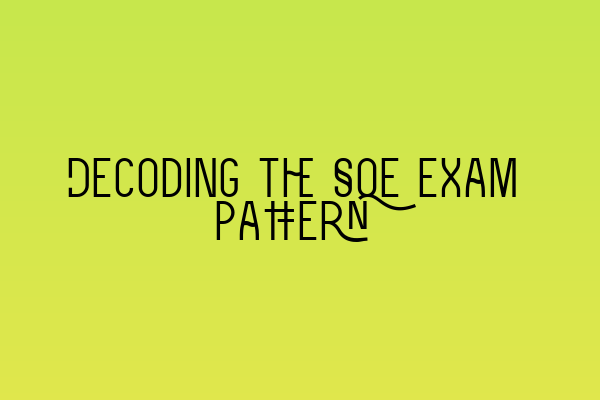Decoding the SQE Exam Pattern
Preparing for the Solicitors Qualifying Examination (SQE) can be a daunting task. As an aspiring solicitor, it is essential to understand the exam pattern to effectively focus your study efforts. In this article, we will decode the SQE exam pattern and provide you with invaluable insights to achieve success.
Structure of the SQE Exam
The SQE exam is divided into two stages: SQE1 and SQE2.
1. SQE1:
The SQE1 is a multiple-choice question (MCQ) exam that tests your knowledge on various legal subjects. It consists of two parts:
- Functioning Legal Knowledge (FLK): This part assesses your understanding of the principles and concepts of law.
- Legal Research and Writing (LRW): In this part, you will have to analyze and apply legal principles to hypothetical scenarios.
To excel in SQE1, it is crucial to have a strong foundation in legal knowledge and develop critical thinking and analytical skills. Practicing sample MCQs and reviewing relevant study materials will greatly enhance your performance.
2. SQE2:
The SQE2 is a practical assessment that evaluates your skills in legal practice. It assesses your ability to apply legal knowledge to real-life scenarios. SQE2 consists of:
- Oral Skills Assessment (OSA): You will participate in simulated client interviews, negotiations, and advocacy exercises. This component tests your oral communication and interpersonal skills.
- Written Skills Assessment (WSA): Here, you will be evaluated on your ability to draft legal documents, such as letters, contracts, and legal advice.
To succeed in SQE2, it is crucial to practice and refine your communication and drafting skills. Mock interviews, negotiation scenarios, and legal writing exercises will help you familiarize yourself with the format and enhance your performance.
Understanding Exam Weightage
While understanding the exam structure is vital, it is equally important to have an insight into the weightage assigned to each component of the SQE exam. This knowledge will help you allocate your study time and resources effectively.
In SQE1, FLK and LRW carry equal weightage. It is essential to dedicate sufficient time to both areas and ensure a balanced preparation.
In SQE2, both OSA and WSA are equally important. Exceptional performance in one component cannot compensate for poor performance in the other. Hence, a holistic approach to preparation is necessary.
Recommended Study Approach
Now that you understand the SQE exam pattern and weightage, it’s time to devise a study plan that maximizes your chances of success. Here are some tips:
- Assess your strengths and weaknesses: Identify the areas where you excel and those that require improvement. This will help you prioritize your study efforts.
- Utilize reliable study materials: Refer to reputable study resources, textbooks, and guides that cover the relevant legal subjects.
- Practice sample questions: Solve a wide range of sample MCQs, hypothetical scenarios, and legal practice exercises to familiarize yourself with the exam format.
- Form study groups: Collaborate with fellow aspiring solicitors to discuss and analyze legal concepts, share study material, and simulate practice scenarios.
- Stay organized: Create a study timetable that ensures each subject and component is given sufficient attention. Allocate regular study breaks to maintain focus and prevent burnout.
- Seek professional guidance: Consider enrolling in SQE training programs or seeking guidance from experienced solicitors or tutors who specialize in coaching for the SQE exam.
Related Articles:
- Key Topics in SQE Land Law: A Roadmap to Exam Success
- Planning Permission and Land Use: Legal Requirements and Considerations
- SQE Prep: Essential Tips and Resources for Success in Property Practice
- Examining Land Charges: Implications and Considerations
- Understanding Landlord Responsibilities in the UK: Legal Obligations Explained
By following these tips and understanding the SQE exam pattern, you can approach the exam with confidence and increase your chances of achieving success. Remember, consistent effort, focused preparation, and a positive mindset are key to unlocking your potential as a qualified solicitor.

Leave a Reply